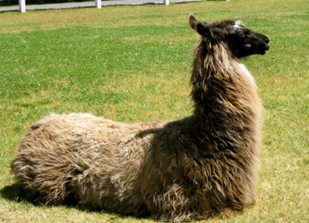CHAPTERS
Navigate to chapter
► Chapter One: All about Llamas
► Chapter Two: Llamas as Pets
► Chapter Three: Getting Acquainted with Llamas
► Chapter Four: Some Facts about Llamas
► Chapter Five: Requirements When Raising Llamas
► Chapter Six: Health Concerns and Care
► Chapter Seven: Husbandry Practices for Llamas
► Chapter Eight: Barn Maintenance and Litter Boxes
► Chapter Nine: Reasons You Should Add Llamas to Your Livestock Herd
► Chapter Ten: Summary and Care Sheet
Chapter One: All about Llamas

People living in South America have long before learnt and have experienced the useful trait of the llama as a packing-animal. They are generally used as aid to transport possessions on wild terrain. They are naturally agile, strong and built for the job of packing. They are also pretty calm animals who make perfect companions for a long hike on, sometimes, inhospitable terrain – making the journey easier and more easy-going. Aside from this, their feet have soft, leathery pads which help their footing. Their soft pads help by causing little damage to vegetation on the trail.
Llamas were brought to the shores of the United States in the 1900s. This chapter will provide you facts and historical backgrounds of Llamas.
The domestication of llamas and their close cousins, the alpacas, paved the way for its place in the ranks of farm animals in North America by the 1800s. This is largely owed to William Randolph Heart, a rich, influential business magnate of the 1900s who brought in a great many of these beautiful beasts of burden to populate the land he owned. Along with other farm animals that resided on the Hearst estate, was some llamas and other exotic species. To date, the Hearst llama collection of a dozen is the largest herd imported from overseas. After an incident of FMD (Foot and Mouth Disease) the importation of llamas was banned. All importation seen after 1930 came from nearby Canada with more than a few of these importations carried out illegally.
Most of these early imports were zoo residents or part of private collections until the 1970s when the early imports became the startup pool of llamas that was to grow the population in the U.S. Being that it was an exotic species, people did not see the need to foster an aggressive breeding program or work on managing breeding practices. Back then, hybridization and inbreeding practices were common. There were, however, a few private breeders and zoos that recognized the unique qualities of the llama. These private groups started administering more desirable management of the breeding methods resulting in more favorable results in terms of animal health.
These were the initial herds which heightened the awareness of humans on the beauty, grace and use of these animals. The presentation of the improved and better bred llamas made people take notice and many had started to see the docility of the llama. They had started to learn of the many useful things they can do side-by-side with these already, long-standing workers from the Andes, and began taking in and rearing these magnificent, friendly beasts as pack animals as well as pets and companions. As years passed, individuals who had been raising these funny-faced looking camelids began seeing the many advantageous traits of the llamas that actually pulled weight around a farm.
By the late seventies, market momentum on the acquisition of llamas began to build. The demand for llamas became so great that the supply was not able to keep up with the clamor for the beautiful beasts. This impacted the increase of the price of the llama in the livestock and pet trade, making many of the interested individuals wait for at least a year, to two, for their llamas.
Since demand outstripped the demand, and waiting lists became a common routine with most breeders, a move was made to lift the ban on import restrictions. After decades of fighting to amend the restrictions, bans on flying in llamas were allowed once again and when llamas were given access and entered the U.S. again.
The cost of transportation and quarantines saw that limited numbers (of several thousands) came into the country. These imports after the ban, along with the original pool of bred llamas that were already in the country, currently represent the population of llamas available in the US.
So popular has the llama become of its abilities to take on and carry heavy loads, as well as its amiable and friendly demeanor, llamas have been the long, constant companions of residents of the high puna of the Andes that finding them on golf greens has become more and more of a norm. Llamas are great companions during camping and hiking trips. They are such great companions along trails and such strong packers who can carry up to 50-65 pounds. Packing llamas are able to help along older backpackers and nature hikers to continuing what they love. They all have different personalities like people. Some are quiet, and others are just a little quirkier. Treat it with respect and they will give you back the same.
Farm raised llamas have been trained to cart, which can be more of a challenge without the proper sort of equipment, however totally possible with the right implements. Because llamas are clever beasts able to repeat actions with proper training and socialization along with the properly built-to-fit cart, they will be able to carry out this task. They are calm animals who are wonderful companion packers on mountain treks and hikes. They allow people to enjoy the hike without having to lug around all that poundage that goes along with camping.
Continue Reading…
Want to read the entire thing?

